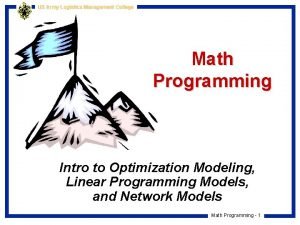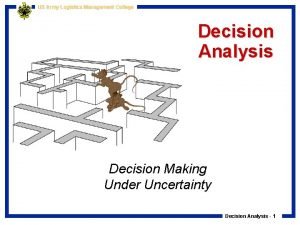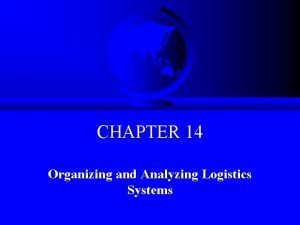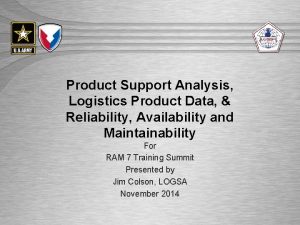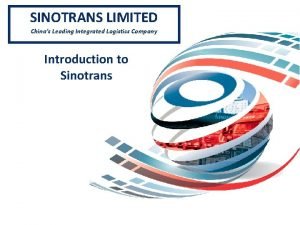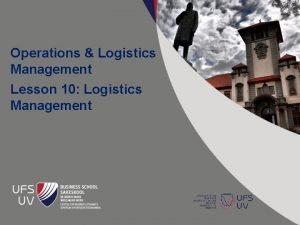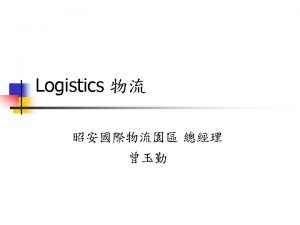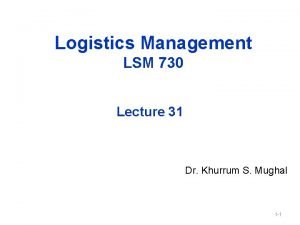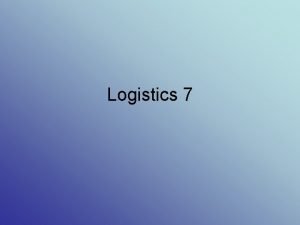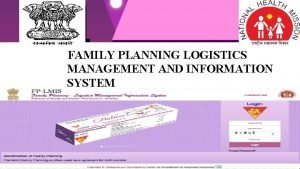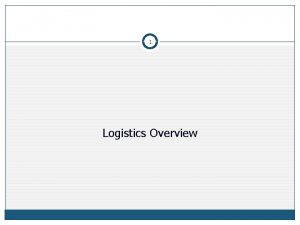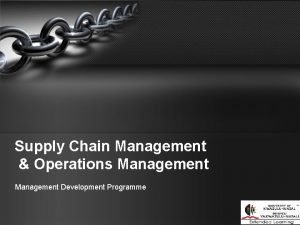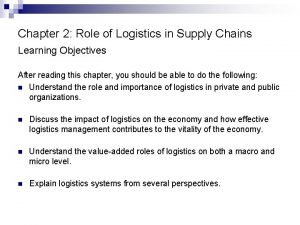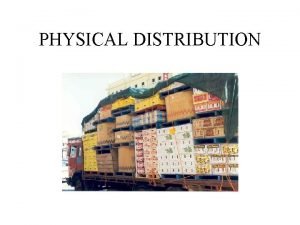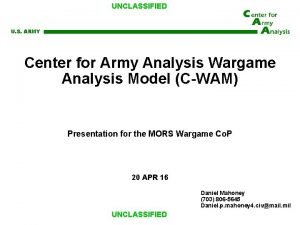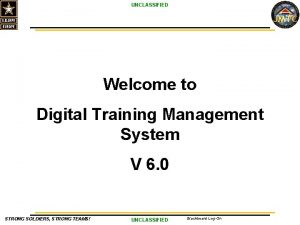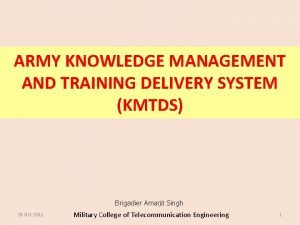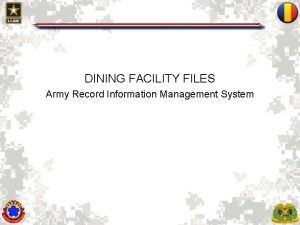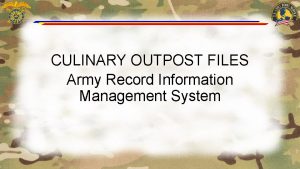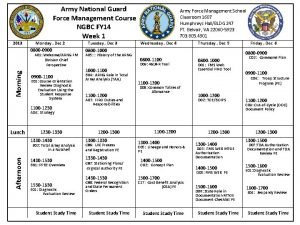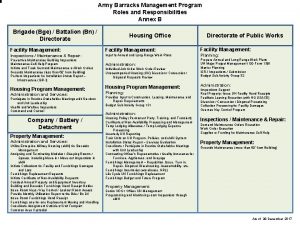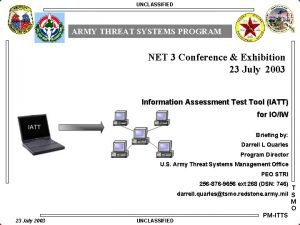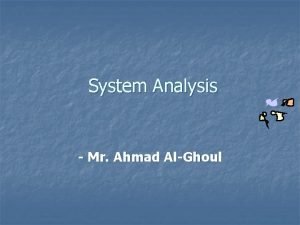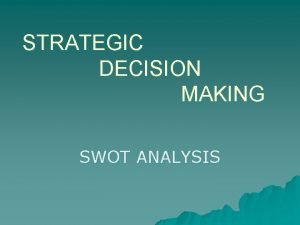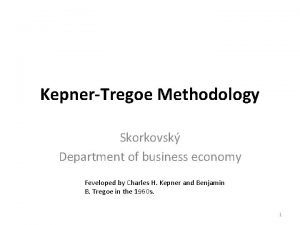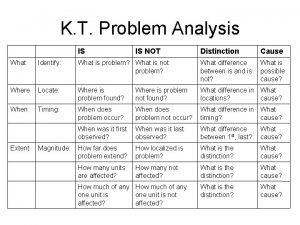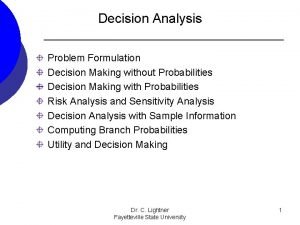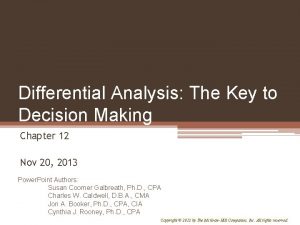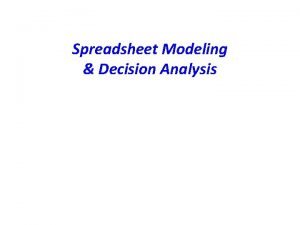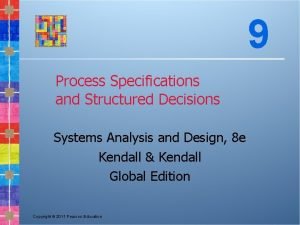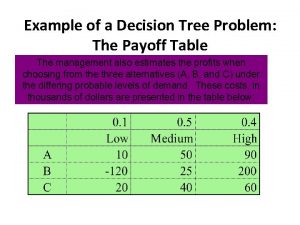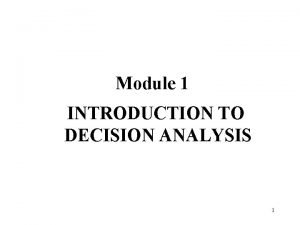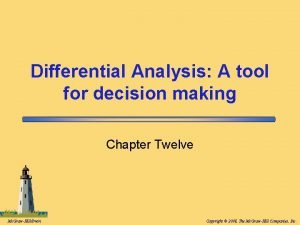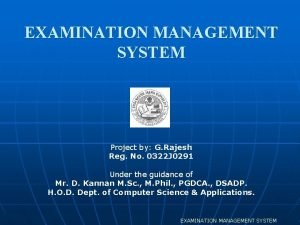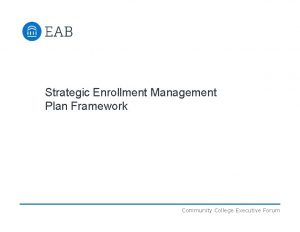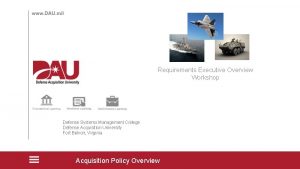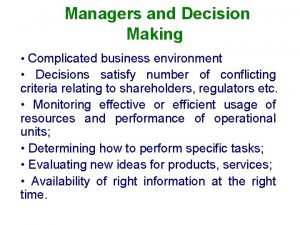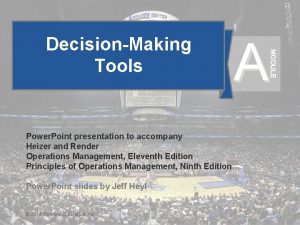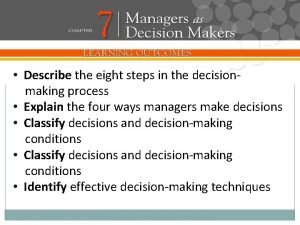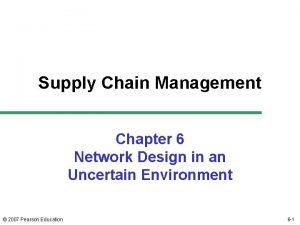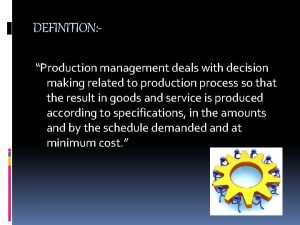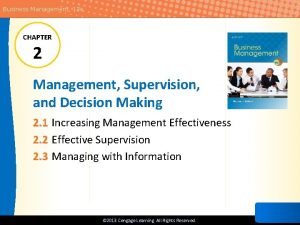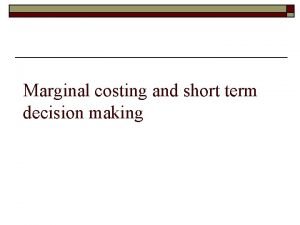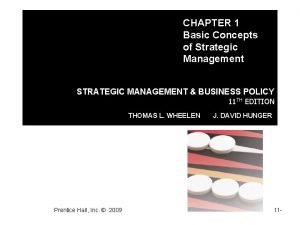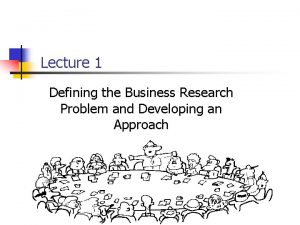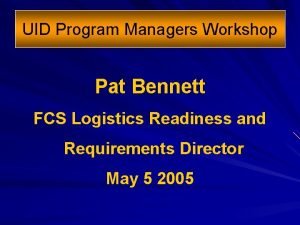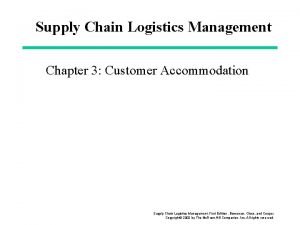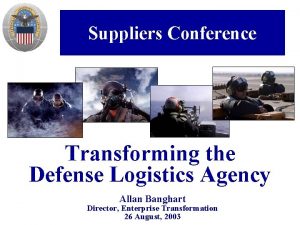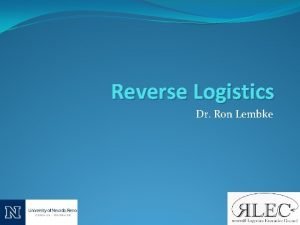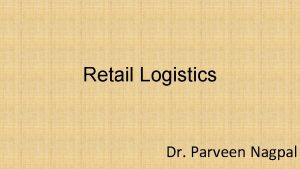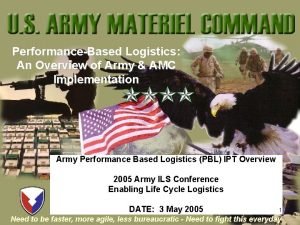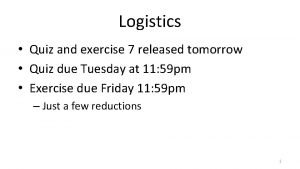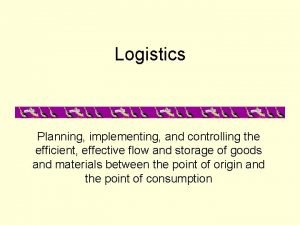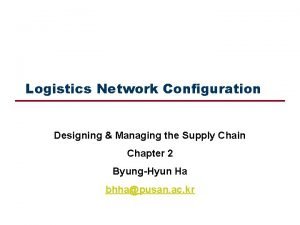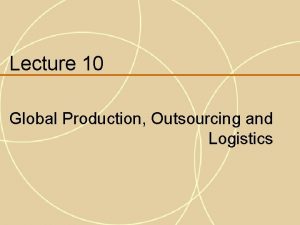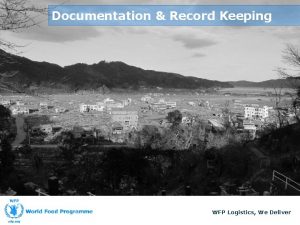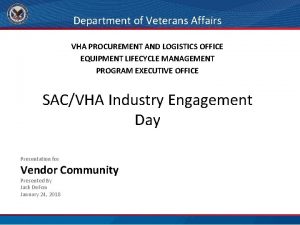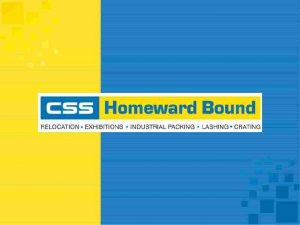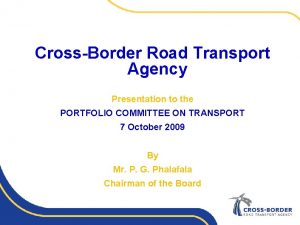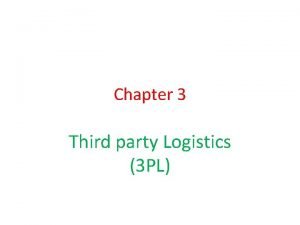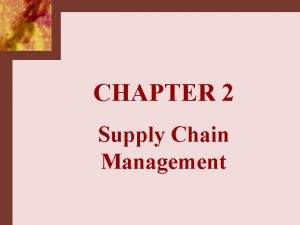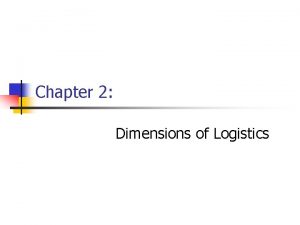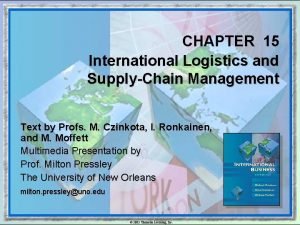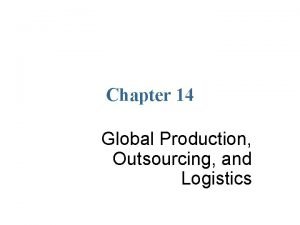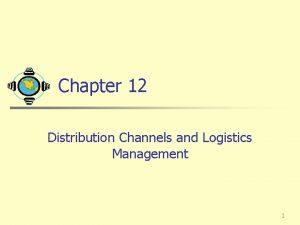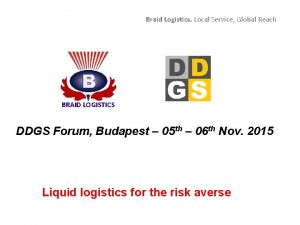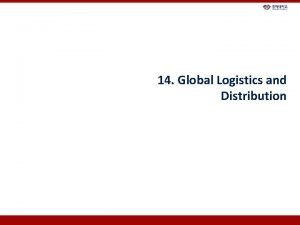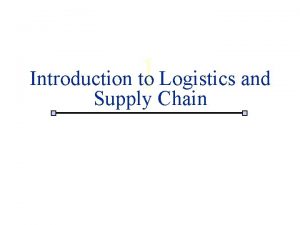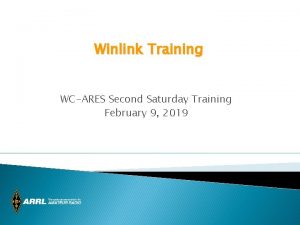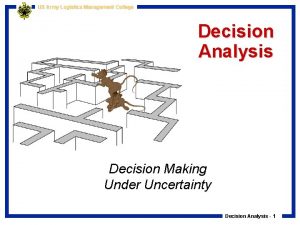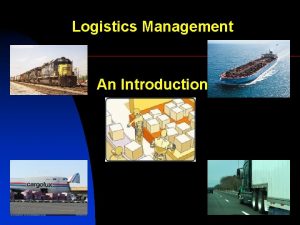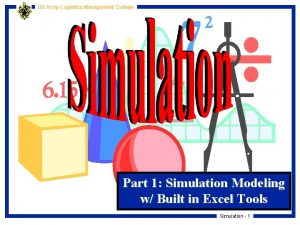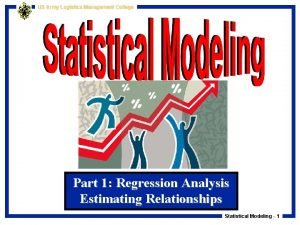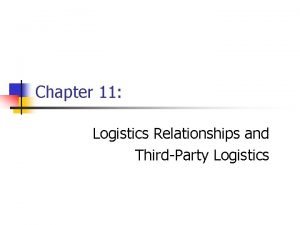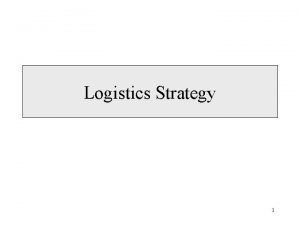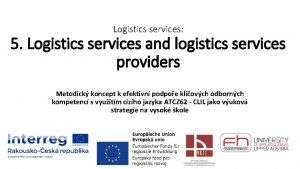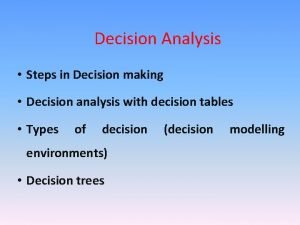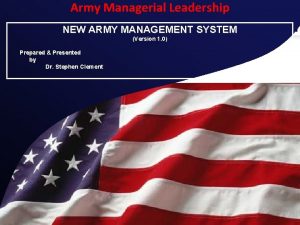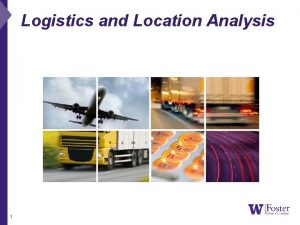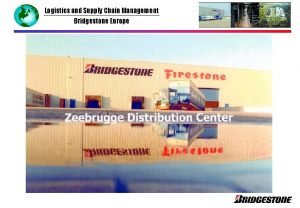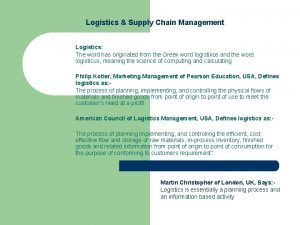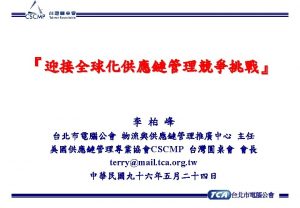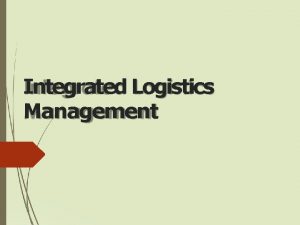US Army Logistics Management College Decision Analysis Decision


































































































































- Slides: 130

US Army Logistics Management College Decision Analysis Decision Making Under Uncertainty Decision Analysis - 1

US Army Logistics Management College Elements of a Decision Analysis Bidding for a Government Contract at Sci. Tools Decision Analysis - 2

US Army Logistics Management College Background Information Bidding for a Government Contract at Sci. Tools • Sci. Tools Incorporated specializes in scientific instruments and has been invited to make a bid on a government contract to provide these instruments this coming year • Sci. Tools estimates that it will cost $5000 to prepare a bid and $95, 000 to supply the instruments • On the basis of past contracts, Sci. Tools estimated the probabilities of the low bid from competitors at a certain dollar level • In addition, they believe there is a 30% chance that there will be no competing bids Decision Analysis - 3

US Army Logistics Management College Decision Making Elements • Although there is a wide variety of contexts in decision making, all decision making problems have three elements: – the set of decisions (or strategies) available to the decision maker – the set of possible outcomes and the probabilities of these outcome – a value model that prescribes results, usually monetary values, for the various combinations of decisions and outcomes • Once these elements are known, the decision maker can find an “optimal” decision Decision Analysis - 4

US Army Logistics Management College Sci. Tools’ Problem Bidding for a Government Contract at Sci. Tools • Sci. Tools decision is whether to submit a bid and how much they should bid (the bid must be greater than $100, 000 for Sci. Tools to make a profit) • Based on the estimated probabilities, Sci. Tools should bid either $115, 000, $120, 000, $125, 000 (we’ll assume that they will never bid less than $115, 000 or more than $125, 000 due to the small profit margin or low chances of winning the bid) • The primary source of uncertainty is the behavior of the competitors - will they bid and, if so, how much? • The behavior of the competitors depends on how many competitors are likely to bid and how the competitors assess their costs of supplying the instruments Decision Analysis - 5

US Army Logistics Management College Sci. Tools’ Problem Bidding for a Government Contract at Sci. Tools • The value model in this example is straightforward but in other examples it is often complex – If Sci. Tools decides right now not to bid, then its monetary values is $0 - no gain, no loss – If they make a bid and are underbid by a competitor, then they lose $5000, the cost of preparing the bid – If they bid B dollars and win the contract, then they make a profit of B - $100, 000; that is, B dollars for winning the bid, less $5000 for preparing the bid, less $95, 000 for supplying the instruments – It is often convenient to list the monetary values in a payoff table Decision Analysis - 6

US Army Logistics Management College Sci. Tools’ Payoff Tables Bidding for a Government Contract at Sci. Tools Payoff Table for Sci. Tools Bidding Example Competitor’s Low Bid ($1000 s) Bid level No Bid <115 >115, <120 >120, <125 >125 No Bid 0 0 0 115 15 -5 15 120 20 -5 -5 20 20 125 25 -5 -5 -5 25 Probability 0. 3 0. 7(0. 2) 0. 7(0. 4) 0. 7(0. 3) 0. 7(0. 1) 0. 3 0. 14 0. 28 0. 21 0. 07 Decision Analysis - 7

US Army Logistics Management College Sci. Tools’ Payoff Tables Bidding for a Government Contract at Sci. Tools Alternative Payoff Table for Sci. Tools Bidding Example Monetary Value Sci. Tools Wins Sci. Tools Loses Probability That Sci. Tools Wins No Bid NA 0 0. 00 115 15 -5 0. 86 120 20 -5 0. 58 125 25 -5 0. 37 Sci. Tools Bid Decision Analysis - 8

US Army Logistics Management College Risk Profiles for Sci. Tools Bidding for a Government Contract at Sci. Tools • A risk profile simply lists all possible monetary values and their corresponding probabilities • From the alternate payoff table we can obtain risk profiles for Sci. Tools – For example, if Sci. Tools bids $120, 000 there are two possibly monetary values, a profit of $20, 000 or a loss of $5000, and their probabilities are 0. 58 and 0. 42, respectively • Risk profiles can be illustrated on a bar chart (the bars above each possible monetary value measure the probability of that value occurring) Decision Analysis - 9

US Army Logistics Management College Sci. Tools’ Expected Monetary Values (EMV) Bidding for a Government Contract at Sci. Tools Alternative EMV Calculation EMV No Bid 0(1) Bid $115, 000(0. 86) +(-5000)(0. 14) $12, 200 Bid $120, 000 (0. 58) + (-5000)(0. 42) $9500 Bid $125, 000(0. 37) + (-5000)(0. 63) $6100 $0 • EMV is a weighted average of the possible monetary values, weighted by their probabilities • What exactly does the EMV mean? – It means that if Sci. Tools were to enter many “gambles” like this, where on each gamble the gains, losses and probabilities were the same, then on average it would win $12, 200 per gamble Decision Analysis - 10

US Army Logistics Management College Decision Tree Conventions Bidding for a Government Contract at Sci. Tools • • • A decision tree is a graphical tool that can represent a decision problem with probabilities Decision trees are composed of nodes (circles, squares and triangles) and branches (lines) The nodes represent points in time - A decision node (a square) is a time when the decision maker makes a decision A probability node (a circle) is a time when the result of an uncertain event becomes known An end node (a triangle) indicates that the problem is completed - all decisions have been made, all uncertainty have been resolved and all payoffs have been incurred Decision Analysis - 11

US Army Logistics Management College Decision Tree Conventions • Bidding for a Government Contract at Sci. Tools Time proceeds from left to right - • • • Branches leading out of a decision node represent the possible decisions Branches leading out of probability nodes represent the possible outcomes of uncertain events Probabilities are listed on probability branches (these probabilities are conditional on the events that have already been observed ) Individual monetary values are shown on the branches where they occur, and cumulative monetary values are shown to the right of the end nodes Two values are often found to the right of each end node: the top one is the probability of getting to that end node, and the bottom one is the associated monetary value Decision Analysis - 12

US Army Logistics Management College Sci. Tools’ Decision Tree Decision Analysis - 13

US Army Logistics Management College Decision Tree Folding Back Procedure Bidding for a Government Contract at Sci. Tools • The solution for the decision tree is on the next slide • The solution procedure used to develop this result is called folding back on the tree • Starting at the right on the tree and working back to the left, the procedure consists of two types of calculations – At each probability node we calculate EMV and write it below the name of the node – At each decision node we find the maximum of the EMVs and write it below the node name • After folding back is completed we have calculated EMVs for all nodes Decision Analysis - 14

US Army Logistics Management College Decision Tree Results Decision Analysis - 15

US Army Logistics Management College The Precision. Tree Add-In • This add-in enables us to build and label a decision tree, but it performs the folding-back procedure automatically and then allows us to perform sensitivity analysis on key input parameters • There are three options to run Precision. Tree: – If Excel is not currently running , you can launch Excel and Precision. Tree by clicking on the Windows Start button and selecting the Precision. Tree item – If Excel is currently running, the procedure in the previous bullet will launch Precision. Tree on top of Excel – If Excel is already running and the Desktop Tools toolbar is showing, you can start Precision. Tree by clicking on its icon Decision Analysis - 16

US Army Logistics Management College Using Precision. Tree Bidding for a Government Contract at Sci. Tools • Inputs: Enter the cost and probability inputs • New tree: Click on the new tree button (the far left button) on the Precision. Tree toolbar, and then click on any cell below the input section to start a new tree. Click on the name box of this new tree to open a dialog box. Type in a descriptive name for the tree. • Decision nodes and branches: To obtain decision nodes and branches, click on the (only) triangle end node to open the dialog box shown here Decision Analysis - 17

US Army Logistics Management College The Precision. Tree Add-In Bidding for a Government Contract at Sci. Tools • We’re calling this decision “Bid? ” and specifying that there are two possible decisions. The tree expands as shown here. • The boxes that say “branch” show the default labels for these branches. Click on either of them to open another dialog box where you can provide a more descriptive name for the branch. Do this to label the two branches “No” and “Yes. ” Also, you can enter the immediate payoff/cost for either branch right below it. Since there is a $5000 cost of bidding, enter the formula =Bid. Cost right below the “Yes” branch in cell B 19. Decision Analysis - 18

US Army Logistics Management College The Precision. Tree Add-In Bidding for a Government Contract at Sci. Tools • More decision branches: The top branch is completed; if Sci. Tools does not bid, there is nothing left to do. So click on the bottom end node, following Sci. Tools’ decision to bid, and proceed as in the previous step to add and label the decision node and three decision branches for the amount to bid. Note that there are no monetary values below these decision branches because no immediate payoffs or costs are associated with the bid amount decision. Decision Analysis - 19

US Army Logistics Management College The Precision. Tree Add-In Bidding for a Government Contract at Sci. Tools • Probability nodes and branches: We now need a probability node and branches from the rightmost end nodes to capture the competition bids – Click on the top one of these end nodes to bring up the dialog box – Click on the red circle box to indicate that this is a probability node. Label it “Any competing bid? ”, specify two branches, and click on OK. – Label the two branches “No” and “Yes”. – Repeat this procedure to form another probability node following the “Yes” branch, call it “Win bid? ”, and label its branches as shown on the next slide. Decision Analysis - 20

US Army Logistics Management College The Precision. Tree Add-In Bidding for a Government Contract at Sci. Tools • Copying probability nodes and branches: You could build the next node and branches or take advantage of Precision. Tree’s copy and paste function. Decision trees can be very “bushy”, but this copy and paste feature can make them much less tedious to construct. Decision Analysis - 21

US Army Logistics Management College • Labeling probability branches: –First enter the probability of no competing bid in cell D 18 with the formula =Pr. No. Bid and enter its complement in cell D 24 with the formula =1 -D 18 –Next, enter the probability that Sci. Tools wins the bid in cell E 22 with the formula =SUM(B 10: B 12) and enter its complement in cell E 26 with the formula =1 -E 22 Decision Analysis - 22

US Army Logistics Management College The Precision. Tree Add-In Bidding for a Government Contract at Sci. Tools • For the monetary values, enter the formula =115000 -Prod. Cost in the two cells, D 19 and E 23, where Sci. Tools wins the contract • Enter the other formulas on probability branches – Using the previous step and the final decision tree as a guide, enter formulas for the probabilities and monetary values on the other probability branches, that is, those following the decision to bid $120, 000 or $125, 000 • We’re finished! The completed tree shows the best strategy and its associated EMV. • Once the decision tree is completed, Precision. Tree has several tools we can use to gain more information about the decision analysis Decision Analysis - 23

US Army Logistics Management College Risk Profile of Optimal Strategy Bidding for a Government Contract at Sci. Tools • Click on the fourth button from the left on the Precision. Tree toolbar (Decision Analysis) and fill in the resulting dialog box (the Policy Suggestion option allows us to see only that part of the tree that corresponds to the best decision) • The Risk Profile option allows us to see a graphical risk of the optimal decision (there are only two possible monetary outcomes if Sci. Tools bids $115, 000) Decision Analysis - 24

US Army Logistics Management College Sensitivity Analysis Bidding for a Government Contract at Sci. Tools • We can enter any values not the input cells and watch how the tree changes • To obtain more systematic information, click on the Precision. Tree sensitivity button • The dialog box requires an EMV cell to analyze at the top and one or more input cells in the middle • The cell to analyze is usually the EMV cell at the far left of the decision tree but it can be any EMV cell • For any input cell (such as the production cost cell) we enter a minimum value, a maximum value, a base value, and a step size • When we click Run Analysis, Precision. Tree varies each of the specified inputs and presents the results in several ways in a new Excel file with Sensitivity, Tornado, and Spider Graph sheets Decision Analysis - 25

US Army Logistics Management College Sensitivity Analysis: Sensitivity Chart Bidding for a Government Contract at Sci. Tools • The Sensitivity sheet includes several charts, a typical one of which appears here • This shows how the EMV varies with the production cost for both of the original decisions • This type of graph is useful for seeing whether the optimal decision changes over the range of input variable Decision Analysis - 26

US Army Logistics Management College Sensitivity Analysis: Tornado Chart Bidding for a Government Contract at Sci. Tools • The Tornado sheet shows how sensitive the EMV of the optimal decision is to each of the selected inputs over the ranges selected • The production cost has the largest effect on EMV, and bid cost has the smallest effect Decision Analysis - 27

US Army Logistics Management College Sensitivity Analysis: Spider Chart Bidding for a Government Contract at Sci. Tools • Finally, the Spider Chart shows how much the optimal EMV varies in magnitude for various percentage changes in the input variables • Again, the production cost has a relatively large effect, whereas the other two inputs have relatively small effects Decision Analysis - 28

US Army Logistics Management College Sensitivity Analysis: Two-Way Analysis Bidding for a Government Contract at Sci. Tools • Use a two-way analysis to see how the selected EMV varies as each pair of inputs vary simultaneously • For each of the possible values of production cost and probability of no competitor bid, this chart indicates which bid amount is optimal • The optimal bid amount remains $115, 000 unless the production cost and the probability of no competing bid are both large. Then it becomes optimal to bid $125, 000 Decision Analysis - 29

US Army Logistics Management College Multistage Decision Trees Marketing a New Product at Acme Decision Analysis - 30

US Army Logistics Management College Background Information • Acme Company is trying to decide whether to market a new product. • As in many new-product situations, there is much uncertainty about whether the product will “catchon”. • Acme believes that it would be prudent to introduce the product to a test market first. • Thus the first decision is whether to conduct the test market. Decision Analysis - 31

US Army Logistics Management College Background Information -continued • Acme has determined that the fixed cost of the test market is $3 million. • If they proceed with the test, they must then wait for the results to decide if they will market the product nationally at a fixed cost of $90 million. • If the decision is not to conduct the test market, then the product can be marketed nationally with no delay. • Acme’s unit margin, the difference between its selling price and its unit variable cost, is $18 in both markets. Decision Analysis - 32

US Army Logistics Management College Background Information -continued • Acme classifies the results in either market as great, fair or awful. • Each of these has a forecasted total units sold as (in 1000 s of units) 200, 100 and 30 in the test market and 6000, 3000 and 900 for the national market. • Based on previous test markets for similar products, it estimates that probabilities of the three test market outcomes are 0. 3, 0. 6 and 0. 1. Decision Analysis - 33

US Army Logistics Management College Background Information -continued • Then based on historical data on products that were tested then marketed nationally, it assesses the probabilities of the national market outcomes given each test market outcome. – If the test market is great, the probabilities for the national market are 0. 8, 0. 15, and 0. 05. – If the test market is fair. then the probabilities are 0. 3, 0. 5, 0. 2. – If the test market is awful, then the probabilities are 0. 05, 0. 25, and 0. 7. • Note how the probabilities of the national market mirrors those of the test market. Decision Analysis - 34

US Army Logistics Management College Elements of Decision Problem • The three basic elements of this decision problem are: – the possible strategies – the possible outcomes and their probabilities – the value model • The possible strategies are clear: – Acme must first decide whether to conduct the test market. – Then it must decide whether to introduce the product nationally. Decision Analysis - 35

US Army Logistics Management College Contingency Plan • If Acme decides to conduct a test market they will base the decision to market nationally on the test market results. • In this case its final strategy will be a contingency plan, where it conducts the test market, then introduces the product nationally if it receives sufficiently positive test market results and abandons the product if it receives negative test market results. • The optimal strategies from many multistage decision problems involve similar contingency plans. Decision Analysis - 36

US Army Logistics Management College Conditional Probabilities continued • The probabilities of the test market outcomes and conditional probabilities of national market outcomes given the test market outcomes are exactly the ones we need in the decision tree. • However, suppose Acme decides not to run a test market and then decides to market nationally. Then what are the probabilities of the national market outcomes? We cannot simply assess three new probabilities. Decision Analysis - 37

US Army Logistics Management College Conditional Probabilities continued • These probabilities are implied by the given probabilities. This follows from the rule of conditional probability. • If we let T 1, T 2, and T 3 be the test market outcomes and N be any national market outcomes, then by the addition rule of probability and the conditional probability formula P(N) = P(N and T 1) + P(N and T 2) and P(N and T 3) =P(N|T 1)P(T 1) + P(N|T 2)P(T 2) + P(N|T 3)P(T 3) Decision Analysis - 38

US Army Logistics Management College Conditional Probabilities continued • This is sometimes called the law of probabilities. • We determine the probabilities as 0. 425 for a great market, 0. 37 for a fair market and 0. 205 for an awful market. • The monetary values are the fixed costs of test marketing or marketing nationally and these are incurred as soon as the “go ahead” decisions are made. Decision Analysis - 39

US Army Logistics Management College ACME. XLS • This file contains the inputs for the decision tree. • The only calculated values in this spreadsheet are in row 28, which follow from the equation. The formula in cell B 28 is =SUMPRODUCT(B 22: B 24, $B$16: $B$18) then it is copied across row 28. • The creation of the tree is then straightforward to build and label. Decision Analysis - 40

US Army Logistics Management College Inputs Decision Analysis - 41

US Army Logistics Management College Decision Analysis - 42

US Army Logistics Management College Interpreting the Tree • The interpretation of the tree is fairly straightforward if we realize that each value just below each node name is an EMV. • Each of these EMVs have been calculated with the folding back procedure. • We can also see Acme’s optimal strategy by following the “TRUE” branches from left to right. Decision Analysis - 43

US Army Logistics Management College Optimal Strategy • Acme should first run a test market and if the results are great then they should market it nationally. • If the test results are fair or awful they should abandon the product. • The risk profile for the optimal strategy can be seen on the next slide. • The risk profile (created by clicking on Preceision. Tree’s “staircase” button and selecting Statistics and Risk Profile options) that there is a small chance of two possible large losses, there is a 70% chance of a moderate loss and there is a 24% chance of a nice profit. Decision Analysis - 44

US Army Logistics Management College Decision Analysis - 45

US Army Logistics Management College Optimal Strategy -- continued • One might argue that the large potential (70%) chance of some loss should persuade Acme to abandon the product right away - without a test market. • This is what “playing the averages” with EMV is all about. • Since the EMV of this optimal strategy is greater than 0, Acme should go ahead with this strategy if it is an EMV maximizer. Decision Analysis - 46

US Army Logistics Management College Expected Value of Sample Information • The role of the test market in this example is to provide Acme with information. • Information usually costs, in this case its fixed cost is $3 million. • From the decision tree we can see that the EMV from test marketing is $807, 000 better than the decision not to test market. The most Acme would be willing to pay for the test marketing is $3. 807 million. • This value is called the expected value of sample information or EVSI. Decision Analysis - 47

US Army Logistics Management College Expected Value of Sample Information -- continued • In general we can write the following expression: EVSI=EMV with free information - EMV without information • For the Acme example the EVSI is $3. 807 million. • The reason for the term sample is that the information does not remove all uncertainty about the future. • That is, even after the test market results are in, there is still uncertainty about the national market. Decision Analysis - 48

US Army Logistics Management College Expected Value of Perfect Information • We can go one step further and ask how much perfect information is worth. • Perfect could be imagined as an envelope containing the final outcome. • No such envelope exists but if it did how much would Acme be willing to pay for it? • This question can be answered with the decision tree shown on the next slide. • Folding back produces an EMV of $7. 65 million. Decision Analysis - 49

US Army Logistics Management College Decision Analysis - 50

US Army Logistics Management College Expected Value of Perfect Information -- continued • This value is called the expected value of perfect information, or EVPI. • The EVPI may appear to be irrelevant because perfect information is almost never available - at any price. • However, it is often used as an upper bound on EVSI for any potential sample information. • That is, no sample information can ever be worth more than the EVPI. Decision Analysis - 51

US Army Logistics Management College Bayes’ Rule Drug Testing College Athletes Decision Analysis - 52

US Army Logistics Management College Background Information • If an athlete is tested for a certain type of drug use, the test will come out either positive or negative. • However, these tests are never perfect. Some athletes who are drug-free test positive (false positives) and some who are drug users test negative (false negatives). We will assume that – 5% of all athletes use drugs – 3% of all tests on drug-free athletes yield false positives – 7% of all tests on drug users yield false negatives. • The question then is what we can conclude from a positive or negative test result. Decision Analysis - 53

US Army Logistics Management College Solution • Let D and ND denote that a randomly chosen athlete is or is not a drug user, and let T+ and Tindicate a positive or negative test result. • We know the following probabilities – First, since 5% of all athletes are drug users, we know that P(D) = 0. 05 and P(ND) = 0. 95. These are called prior probabilities because they represent the chance that an athlete is or is not a drug user prior to the results of a drug test. Decision Analysis - 54

US Army Logistics Management College Solution -- continued – Second, from the information on drug test accuracy, we know the conditional probabilities P(T+|ND) = 0. 08 and P(T|D)= 0. 03. – But a drug-free athlete either tests positive or negative, and the same is true for a drug user. Therefore, P(T-|ND) = 0. 92 and P(T+|D) = 0. 97. – These four conditional probabilities of test results given drug user status are often called the likelihoods of the test results. • Given these priors and likelihoods we want posterior probabilities such as P(D|T+) or P(ND|T-). Decision Analysis - 55

US Army Logistics Management College Solution -- continued • These are called posterior probabilities because they are assessed after the drug test results. This is where Baye’s rule enters. • Bayes’ Rule says that a typical posterior probability is a ratio. The numerator is a likelihood times a prior, and the denominator is the sum of likelihoods times priors. Decision Analysis - 56

US Army Logistics Management College DRUGBAYES. XLS • This file shows how easy it is to implement Bayes’ rule in a spreadsheet. • The given priors and likelihoods are listed in the ranges B 5: C 5 and B 9: C 10. Decision Analysis - 57

US Army Logistics Management College Calculations • We calculate the products of likelihoods and priors in the range B 15: C 16. The formula in cell B 15 is =B$5*B 9 and it is copied to the rest of B 15: C 16 range. • Their row sums are calculated in the range D 15: D 16. These represent the unconditional probabilities of the two possible results. They are also the denominator of Bayes’ rule. • Finally we calculate the posterior probabilities in the range B 21: C 22. The formula in B 21 is =B 15/$D 15 and it is copied to the rest of the range B 21: C 22. Decision Analysis - 58

US Army Logistics Management College Resulting Probabilities • A negative test result leaves little doubt that the athlete is drug-free; this probability is 0. 996. • A positive test result leaves a lot of doubt of whether the athlete is drug-free. The probability that the athlete uses drugs is 0. 620. • Since only 5% of athletes use drugs it takes a lot of evidence to convince us otherwise. This plus the fact that the test produces false positives means the athletes that test positive still have a decent chance of being drug-free. Decision Analysis - 59

US Army Logistics Management College Background Information • The administrators at State University are trying to decide whether to institute mandatory drug testing for the athletes. • They have all the same information of priors and likelihoods as the previous example. • They want to use a decision tree approach to see whether the benefits outweigh the costs Decision Analysis - 60

US Army Logistics Management College Decision Alternatives • We will assume that there are only two alternatives: – perform drug testing on all athletes – don’t perform any drug testing. • In the former case we assume that if an athlete tests positive, this athlete is barred from sports. Decision Analysis - 61

US Army Logistics Management College Monetary Values • The “monetary” values are more difficult to assess. They include: – the benefit B from correctly identifying a drug user and barring him or her from sports – the cost C 1 of the test itself for a single athlete (materials and labor) – the cost C 2 of falsely accusing a nonuser (and barring him or her from sports) – the cost C 3 of not identifying a drug user (either by not testing at all or by obtaining a false negative) – the cost C 4 of violating a nonuser’s privacy by performing the test Decision Analysis - 62

US Army Logistics Management College Monetary Values -- continued • Only C 1 is a direct monetary cost that is easy to measure. • The other costs and the benefit are real, and they must be compared on some scale to enable administrators to make a rational decision. • We will do this by comparing everything to C 1 to which we will assign a value 1. • There is a lot of subjectivity so sensitivity analysis on the final decision is a must. Decision Analysis - 63

US Army Logistics Management College Benefit-Cost Table • Before constructing the decision tree it is useful to form a benefit-cost table for both alternatives and all possible outcomes. • All benefits in this table have a positive sign and all costs have a negative sign. Net Benefit for Drug-Testing Example Don’t Test Perform Test D ND D and T+ ND and T+ D and T- ND and T- -C 3 0 B – C 1 -(C 1 + C 2 + C 4) - (C 1 + C 3) - (C 1 + C 4) Decision Analysis - 64

US Army Logistics Management College DRUG. XLS • This file provides the data to create the decision tree with Precision. Tree. • First, we enter the input data and then along with Bayes’ rule calculations from before we can create the tree and enter the links to the values and probabilities. Decision Analysis - 65

US Army Logistics Management College Timing • Before interpreting the tree we need to discuss the timing (from left to right). • If drug testing is performed, the result of the drug test is observed first (a probability node). • Each result leads to an action (bar from sports or don’t), and then the eventual benefit or cost depends on whether the athlete uses drugs (again a probability node). • If no drug testing is performed, then there is no intermediate test result node or branches. Decision Analysis - 66

US Army Logistics Management College Interpretation • First, we discuss the benefits and costs. – The largest cost is falsely accusing (and barring) a nonuser. – This is 50 times as large as the cost of the test. – The benefit of identifying a drug user is only half this large, and the cost of not identifying a user is 40% as large as barring a nonuser. – The violation of privacy of a nonuser is twice as large as the cost of the test. • Based on these values, the decision tree implies that drug testing should not be performed. The EMVs are both negative; thus costs outweigh benefits. Decision Analysis - 67

US Army Logistics Management College Interpretation -- continued • What would it take to change this decision? • Most people in society would agree that the costs of falsely accusing a nonuser should be the largest cost. In fact, with legal costs we might argue that it should be more than 50 times the cost of the test. • On the other hand, if the benefit of identifying a user and/or the cost C 3 for not identifying a user increase, the testing might be the preferred alternative. • We can test this by varying the benefits and the costs. Decision Analysis - 68

US Army Logistics Management College Interpretation -- continued • Other than benefits and costs, the only thing that we might vary is the accuracy of the test, measured by the error probabilities. • Even when each error probability was decreased to 0. 01, the no-testing alternative was still optimal. • In summary, based on a number of reasonable assumptions and parameter settings, this example has shown that it is difficult to make a case for mandatory drug testing. Decision Analysis - 69

US Army Logistics Management College Decision Analysis Attitudes Toward Risk and Multi-attribute Decision Making Decision Analysis - 70

US Army Logistics Management College Utility Functions • A utility function is a mathematical function that transforms monetary values – payoffs and costs – into utility values. • Most individuals are risk averse, which means intuitively that they are willing to sacrifice some EMV to avoid risky gambles. • If a person is indifferent, then the expected utilities from the two options must be equal. We will call the resulting value the indifference value. Decision Analysis - 71

US Army Logistics Management College Example • John Jacobs owns his own business. • Because he is about to make an important decision where large losses or large gains are at stake, he wants to use the expected utility criterion to make his decision. • He knows that he must first assess his own utility function, so he hires a decision analysis expert, Susan Schilling, to help him out. • How might the session between John and Susan proceed? Decision Analysis - 72

US Army Logistics Management College Solution • Susan first asks John for the largest loss and largest gain he can imagine. • He answers with the values $200, 000 and $300, 000, so she assigns utility values U(-200, 000) = 0 and U(300, 000) = 1 as anchors for the utility function. • Now she presents John with the choice between two options – Option 1: Obtain a payoff of z (really a loss if z is negative). – Option 2: Obtain a loss of $200, 000 or a payoff of $300, 000, depending on the flip of a fair coin. Decision Analysis - 73

US Army Logistics Management College Solution -- continued • Susan reminds John that the EMV of option 2 is $50, 000. • He realizes this, but because he is quite risk averse, he would far rather have $50, 000 for certain than take the gamble for option 2. • Therefore the indifference value of z must be less than $50, 000. • Susan then poses several values of z to John. Decision Analysis - 74

US Army Logistics Management College Solution -- continued • Would he rather have $10, 000 for sure or take option 2? He says he would rather take this $10, 000. • Would he rather pay $5000 for sure or take option 2. He says he would rather take option 2. • By this time, we know the indifference value of z must be less than $10, 000 and greater than -$5000. • With a few more questions of this type, John finally decides on z=$5000 as his indifference value. He is indifferent between obtaining $5000 for sure and taking the gamble in option 2. Decision Analysis - 75

US Army Logistics Management College Solution -- continued • We can substitute these values into the equation: U(5000) = 0. 5 U(-200, 000) + 0. 5 U(300, 000) = 0. 5(0) + 0. 5(1) = 0. 5 • Note that John is giving up $45, 000 in EMV because of his risk aversion. • The EMV of the gamble in option 2 is $50, 000, and he is willing to accept a sure $5000 in its place. • The process would then continue. For example, since she now knows U(5000) and U(300, 000), Susan could ask John to choose between these options: Decision Analysis - 76

US Army Logistics Management College Solution -- continued – Option 1: Obtain a payoff of z. – Option 2: Obtain a payoff of $5000 or a payoff of $300, 000, depending on the flip of a fair coin. • If John decides that his indifference value is now z = $130, 000, then with the equation we know that U(130, 000) = 0. 5 U(5000) + 0. 5 U(300, 000) = 0. 5(0. 5) + 0. 5(1) = 0. 75 • Note that John is now giving up $22, 500 in EMV because the EMV of the gamble in option 2 is $152, 500. By continuing in this manner, Susan can help John assess enough utility values to approximate a continuous utility curve. Decision Analysis - 77

US Army Logistics Management College Incorporating Attitudes Toward Risk Deciding Whether to Enter Risky Ventures at Venture Limited Decision Analysis - 78

US Army Logistics Management College Background Information • Venture Limited is a company with net sales of $30 million. The company currently must decide whether to enter one of two risky ventures or do nothing. • The possible outcomes of the less risky venture are $0. 5 million loss, a $0. 1 million gain, and a $1 million gain. • The probabilities of these outcomes are 0. 25, 0. 50, and 0. 25. • The possible outcomes of the most risky venture is $1 million loss, a $1 million gain, and a $3 million gain. Decision Analysis - 79

US Army Logistics Management College Background Information -continued • The probabilities of these outcomes are 0. 35, 0. 60, and 0. 05. • If Venture Limited can enter at most one of the two risky ventures, what should it do? Decision Analysis - 80

US Army Logistics Management College Solution • We will assume that Venture Limited has an exponential utility function. • An exponential utility function has only one adjustable numerical parameter, and there are straightforward ways to discover the most appropriate value of this parameter for a particular individual or company. • Also, based on Howard’s guidelines, we will assume that the company’s risk tolerance is 6. 4% of its net sales, or 1. 92 million. Decision Analysis - 81

US Army Logistics Management College Solution -- continued • We can substitute into the equation to find the utility of any monetary outcome. • For example, the gain from doing nothing is $0, and its utility is U(0) = 1 e-0/1. 92 = 1 -1 = 0. As another example, the utility of a $1 million loss is U(-1) = 1 – e(-1)/1. 92 = 1 – 1. 683 = - 0. 683. • These are the values we use (instead of monetary values) in the decision tree. Decision Analysis - 82

US Army Logistics Management College Using Precision. Tree • Fortunately, Precision. Tree takes care of all the details. • After we build a decision tree and label it in the usual way, we click on the name of the tree to open the dialog box shown here. Decision Analysis - 83

US Army Logistics Management College Using Precision. Tree • We then fill in the utility function information as shown in the upper right section of the dialog box. • This says to use an exponential function with risk tolerance 1. 92. • It also indicates that we want the expected utilities (as opposed to EMVs) to appear in the decision tree. Decision Analysis - 84

US Army Logistics Management College VENTURE. XLS • We build our tree exactly the same way and link probabilities and monetary values to its branches in the usual way. • For example, there is a link in cell C 22 to the monetary value in cell A 10. However, the expected values shown in the tree are expected utilities, and the optimal decision is the one with the largest expected utility. • In this case the expected utilities for doing nothing, investing in the less risky venture, and investing in the more risky venture are 0, 0. 0525, and 0. 0439. Therefore, the optimal decision is to invest in the less risky venture. Decision Analysis - 85

US Army Logistics Management College Solution -- continued • Note that the EMVs of the three decisions are $0, $0. 175 million, and $0. 4 million. The later of these are calculated in row 14 as the usual “sumproduct” of monetary values and probabilities. • How sensitive is the optimal decision to the key parameter, the risk tolerance? • We can answer this by changing the risk tolerance and watching how the tree changes. • So the optimal decision depends heavily on the attitudes toward risk of Venture Limited’s top management. Decision Analysis - 86

US Army Logistics Management College Certainty Equivalents • Now suppose that Venture Limited has only two options. • It can enter the less risky venture or receive a certain dollar amount x and avoid the gamble altogether. • We want to find the dollar amount x such that the company is indifferent between these two options. • If it enters the risky venture, its expected utility is 0. 0525, calculated above. If he receives x dollars for certain, its (expected) utility is U(x) = 1 – e-x/1. 92. Decision Analysis - 87

US Army Logistics Management College Certainty Equivalents -continued • To find the value x where it is indifferent between the two options, we set 1 – e-x/1. 92 equal to 0. 0525 or e-x/1. 92 = 0. 9475, and solve for x. • Taking natural logarithms of both sides and multiplying by – 1. 92, we obtain x = 1. 92 ln(0. 9475) ~ $0. 104 million. • This value is called the certainty equivalent of the risky venture. Decision Analysis - 88

US Army Logistics Management College Certainty Equivalents -continued • The company is indifferent between entering the less risky venture and receiving $0. 104 million to avoid it. • Although the EMV of the less risky venture is $0. 175 million, the company acts as if it is equivalent to a sure $0. 104 million. • In this sense, the company is willing to give up the difference in EMV, $71, 000, to avoid a gamble. • By a similar calculation, the certainty equivalent of the more risky venture is approximately $0. 086 million, when in fact its EMV is a hefty $0. 4 million! Decision Analysis - 89

US Army Logistics Management College Certainty Equivalents -continued • So in this case it is willing to give up the difference in EMV, $314, 000, to avoid this particular gamble. • Again, the reason is that the company dislikes risk. • We can see these certainty equivalents in Precision. Tree by adjusting the Display box to show Certainty Equivalent. • The tree then looks like the on the next slide. • The certainty equivalents we just discussed appear in cells C 24 and C 32. Decision Analysis - 90

US Army Logistics Management College Decision Analysis - 91

US Army Logistics Management College Multi-attribute Decision Making Using AHP to Select a Job Decision Analysis - 92

US Army Logistics Management College Background Information • Jane is about to graduate from college and is trying to determine which job to accept from among three options. • She plans to choose among the offers by determining how well each job offer meets the following four objectives: – Objective 1: High starting salary – Objective 2: Quality of life in city where job is located – Objective 3: Interest of work – Objective 4: Nearness of job to family Decision Analysis - 93

US Army Logistics Management College Value structure properties How do we determine proper objectives? • Completeness (covers all concerns) • Non-redundant (no overlap) • Decomposable (can consider each objective without considering others) • Operability (must be understandable) • Number of objectives (smaller generally better) Decision Analysis - 94

US Army Logistics Management College Objectives Assessment Determine attribute measures for each objective • Salary (measure annual salary in $K & assume that other benefits and cost of living in different locations are similar) Job 1: $40 K Job 2: $36 K Job 3: $28 K • Quality of life (based on subjective 1 -10 rating done by Jane using reference material) Job 1: 5 Job 2: 6 Job 3: 8 • Work interest (based on subjective 1 -10 rating using job description and interview) Job 1: 3 Job 2: 9 Job 3: 6 • Nearness to family (measured in travel time) Job 1: 3 hours Job 2: 1 hour Job 3: 20 minutes Decision Analysis - 95

US Army Logistics Management College Additive Weighting Approach • Develop a value function – Transform attribute measures from quantitative/qualitative measures into a linear scaled measure – Assess and normalize weights for each attribute – Each alternative receives a value score (sum of attribute measures weighted by objective weights) – Preferred alternative has the largest value score • Simple Additive Weighting Template Decision Analysis - 96

US Army Logistics Management College Transforming Attribute Measures • We want scales with the following properties: – Interval scale (difference between values has meaning) – Consistent units of measurement – Scales in the same direction • We will use a linear proportional scale: Max Attribute: Rescaled Score = Attribute Value Max Attribute Value Min Attribute: Rescaled Score = Min Attribute Value Decision Analysis - 97

US Army Logistics Management College Assess & Normalize Weights • Weights should be based on importance relative to the range of values for each attribute • How much more/less important are the following attributes relative to each other? – Salary (ranging from $28 K to $40 K) – Quality of life (ranging from 5 to 8 on a 10 point scale) – Work interest (ranging from 3 to 9 on a 10 point scale) – Nearness to family (ranging from 20 min to 3 hr) • Rank order attributes, give most important attribute a top score, other scores relative to best • Normalize: divide each weight by the sum of weighted scores (sum of normalized weights equal 1) Decision Analysis - 98

US Army Logistics Management College Determine Value Score • Use weights of salary=10, work interest=5, near to family=3 and quality of life=2 • Final value scores: Job 1=. 66, Job 2=. 82, Job 3=. 77 • Preferred option is Job 2 (although Job 3 is close enough to examine these two jobs against each other) • Sensitivity analysis is important due to subjectivity • Always present and rationalize preferred option based on objectives (why was Job 2 preferred? –best for work interest, overall strong on all objectives) • Job 3 does well due to dominance in nearness to family (may consider rescaling attribute measure or importance if this does not seem reasonable) Decision Analysis - 99

US Army Logistics Management College Analytic Hierarchy Process (AHP) • Transform objective measures from quantitative or qualitative measures using pairwise comparisons and an intensity scale of relative importance • Assess weights using the same pairwise comparison method • Each alternative receives a weighted score (sum of objective measures weighted by objective weights) • Preferred alternative has the largest weighted score Decision Analysis - 100

US Army Logistics Management College Solution • To illustrate how AHP works, suppose that Jane is facing three job offers and must determine which offer to accept. • In this example there are four objectives, as listed earlier. • For each objective, AHP generates a weight (by a method to be described shortly). • By convention, the weights are always chosen so that they sum to 1. Decision Analysis - 101

US Army Logistics Management College Pairwise Comparison Matrices • To obtain the weights for the various objectives, we begin by forming a matrix A, known as the pairwise comparison matrix. • The entry in row i and column j of A, labeled aij, indicates how much more (or less) important objective i is than objective j. • “Importance” is measured on an integer-valued 19 scale with each number having the interpretation shown in the table. Decision Analysis - 102

US Army Logistics Management College Pairwise Comparison Matrices - continued Interpretation of Values in Pairwise Comparison Matrix Value of aij Interpretation 1 Objective i and j are equally important. 3 Objective i are slightly more important than j. 5 Objective i are strongly more important than j. 7 Objective i are very strongly more important than j. 9 Objective i are absolutely more important than j. • The phrases in this table, such as “strongly more important than, ” are suggestive only. • They simply indicate discrete points on a continuous scale that can be used to compare the relative importance of any two objectives. Decision Analysis - 103

US Army Logistics Management College Pairwise Comparison Matrices - continued • For example, if a 13 = 3, then objective 1 is slightly more important than objective 3. If aij = 4, a value not in the table, then objective i is somewhere between slightly and strongly more important than objective j. • If objective i is less important then objective j, we use the reciprocal of the appropriate index. • For example, if objective i is slightly less important than objective j, the aij = 1/3. • Finally, for all objectives i, we use the convention that aij = 1. Decision Analysis - 104

US Army Logistics Management College Pairwise Comparison Matrices - continued • For consistency, it is necessary to set aij = 1/aij. • This simply states that if objective 1 is slightly more important than objective 3, then objective 3 is slightly less important than job 1. • It is usually easier to determine all aij’s that are greater than 1 and then use the relationship aij = 1/aij to determine the remaining entries in the pairwise comparison matrix. Decision Analysis - 105

US Army Logistics Management College Pairwise Comparison Matrices - continued • To illustrate, suppose that Jane has identified the following pairwise comparison matrix for her four objectives: • The rows and columns of A each correspond to Jane’s four objectives: salary, quality of life, interest of work, and nearness to family. Decision Analysis - 106

US Army Logistics Management College Pairwise Comparison Matrices - continued • The entries in this matrix have built-in pairwise consistency because we require aij = 1/aij for each i and j. • However, they may not be consistent when three alternatives are considered simultaneously. • For example, Jane claims that salary is strongly more important than quality of life (a 12 = 5) and that salary is very slightly more important than interesting work (a 13 = 2). But she also says that interesting work is very slightly more important than quality of life (a 32 = 2). Decision Analysis - 107

US Army Logistics Management College Pairwise Comparison Matrices - continued • The question is whether these ratings are all consistent with one another. • They are not, at least not exactly. • It can be shown that some of Jane’s pairwise comparisons, slight inconsistencies are common and fortunately do not cause serious difficulties. • An index that can be used to measure the consistency of Jane’s preferences will be discussed later in this section. Decision Analysis - 108

US Army Logistics Management College Determining the Weights • Although the ideas behind AHP are fairly intuitive, the mathematical reasoning required to derive the weights for the objectives is quite advanced. Therefore, we simply describe how it is done. • Starting with the pairwise comparison matrix A, we find the weights for Jane’s four objectives using the following two steps. Decision Analysis - 109

US Army Logistics Management College Determining the Weights -continued 1. For each of the columns of A, divide each entry in the column by the sum of the entries in the column. This yields a new matrix (call it Anorm, for “normalized”) in which the sum of the entries in each column is 1. For Jane’s pairwise comparison matrix, this step yields Decision Analysis - 110

US Army Logistics Management College Determining the Weights -continued 2. Estimate wi, the weight for objective i, as the average of the entries in row i of Anorm. For Jane’s matrix this yields Decision Analysis - 111

US Army Logistics Management College Determining the Weights -continued • Intuitively, why does wi approximate the weight for objective 1 (salary)? Here is the reasoning. • The proportion of weight that salary is given in pairwise comparisons of each objective to salary is 0. 5128. Similarly, 0. 50 represents the proportion of total weight that salary is given in pairwise comparisons of each objective to quality of life. • Therefore, we see that each of the four numbers averaged to obtain wi represents a measure of the total weight attached to salary. Averaging these numbers should give a good estimate of the proportion of the total weight given to salary. Decision Analysis - 112

US Army Logistics Management College Determining the Score of Each Decision Alternative on Each Objective • Now that we have determined the weights, we need to determine how well each job scores on each objective. • To determine these scores, we use the same scale described in the table to construct a pairwise comparison matrix for each objective. • Consider the salary objective, for example. Suppose that Jane assesses the following pairwise comparison matrix. Decision Analysis - 113

US Army Logistics Management College Determining the Score of Each Decision Alternative on Each Objective -- continued • We denote this matrix as A 1 because it reflects her comparisons of the three jobs with respect to the first objective of salary. • The rows and columns of this matrix correspond to the three jobs. For example, the first row means that Jane believes job 1 is superior to job 2 (and even more superior than job 3) in terms of salary. Decision Analysis - 114

US Army Logistics Management College Determining the Score of Each Decision Alternative on Each Objective -- continued • To find the relative scores of the three jobs on salary, we now apply the same two-step procedure we did earlier to the salary pairwise comparison matrix A 1. That is we first divide each column entry by the column sum to obtain Decision Analysis - 115

US Army Logistics Management College Determining the Score of Each Decision Alternative on Each Objective -- continued • Then we average the numbers in each row to obtain the vector of scores for the three jobs on salary, denoted by S 1: • That is, the scores for jobs 1, 2, and 3 on salary are 0. 5714, 0. 2857, and 0. 1429. In terms of salary, job 1 is clearly the favorite. Decision Analysis - 116

US Army Logistics Management College Determining the Score of Each Decision Alternative on Each Objective -- continued • Next we repeat these calculations for Jane's other objectives. • Each of these objective requires a pairwise comparison matrix, which we will denote as A 2, A 3, A 4. • Suppose that Jane’s pairwise comparison matrix for quality of life is Decision Analysis - 117

US Army Logistics Management College Determining the Score of Each Decision Alternative on Each Objective -- continued • Then the corresponding normalized matrix is and by averaging, we obtain • Here, Job 3 is the clear favorite. However this might not have much impact because Jane puts relatively little weight on quality of life. Decision Analysis - 118

US Army Logistics Management College Determining the Score of Each Decision Alternative on Each Objective -- continued • For interest of work, suppose the pairwise comparison matrix is • Then the same type calculations show that the scores for jobs 1, 2, and 3 on interest of work are Decision Analysis - 119

US Army Logistics Management College Determining the Score of Each Decision Alternative on Each Objective -- continued • Finally, suppose the pairwise comparison matrix for nearness to family is • In this case the scores for jobs 1, 2, and 3 on nearness to family are Decision Analysis - 120

US Army Logistics Management College Determining the Best Alternative • Let’s summarize what we determined so far. – Jane first assesses a pairwise comparison matrix A that measures the relative importance of each of her objectives to one another. – From this matrix we obtain a vector of weights that summarizes the relative importance of the objectives. – Next, Jane assesses a pairwise comparison matrix Ai for each objective i. This matrix measures how well each job compares to other jobs with regard to this objective. For each matrix Ai we obtain a vector of scores Si that summarizes how the jobs compare in terms of achieving objective i. Decision Analysis - 121

US Army Logistics Management College Determining the Best Alternative -- continued • The final step is to combine the scores in the Si vectors with the weights in the w vector. • Actually we have already done this. Note that the columns of the Table are the Si vectors we just obtained. • If we form a matrix S of these score vectors and multiply this matrix by w, we obtain a vector of overall scores for each job, as shown on the next slide. Decision Analysis - 122

US Army Logistics Management College Determining the Best Alternative -- continued • These are the same overall scores that we obtained earlier. As before, the largest of these overall scores is for job 2, so AHP suggests Jane should accept this job. Job 1 follows closely behind, with job 3 somewhat farther behind. Decision Analysis - 123

US Army Logistics Management College Checking the Consistency • As mentioned earlier, any pairwise comparison matrix can suffer from inconsistencies. • We now describe a procedure to check for inconsistencies. • We illustrate this on the A matrix and its associated vector of weights w. The same procedure can be used on any of the Ai matrices and their associated “weights” vector Si. Decision Analysis - 124

US Army Logistics Management College Checking the Consistency -continued 1. Compare Aw. For the example, we obtain 2. Find the ratio of each element of Aw to the corresponding weight in w and average these ratios. For the example, this calculation is Decision Analysis - 125

US Army Logistics Management College Checking the Consistency -continued • Compute the consistency index (labeled CI) as where n is the number of objective. For the example this is • Compare CI to the random index (labeled RI) in the table on the next slide for the appropriate value of n. Decision Analysis - 126

US Army Logistics Management College Checking the Consistency -continued Random Indices for Consistency Check for AHP Example N 2 3 4 5 6 7 8 9 10 RI 0 0. 58 0. 90 1. 12 1. 24 1. 32 1. 41 1. 45 1. 51 • To be perfectly consistent decision maker, each ratio in Step 2 should equal n. This implies that a perfectly consistent decision maker has CI = 0. • The values of RI in the table give the average values of CI if the entries in A were chosen at random. Decision Analysis - 127

US Army Logistics Management College Checking the Consistency -continued • If the ratio of CI to RI is sufficiently small, then the decision maker’s comparisons are probably consistent enough to be useful. • Saaty suggests that if CI/RI < 0. 10, then the degree of consistency is satisfactory, whereas if CI/RI > 0. 10, serious inconsistencies exist and AHP may not yield meaningful results. • In Jane’s example, CI/RI = 0. 159/0. 90 = 0. 0177, which is much less than 0. 10. Therefore Jane’s pairwise comparison matrix A does not exhibit any serious inconsistencies. Decision Analysis - 128

US Army Logistics Management College AHP Template • The Template file will perform all of the calculations, including consistency indices and ratios. • The next slide shows the pairwise judgments used by Jane • Using Jane’s information, Job 2 has the highest preference score, followed by Job 1 and then Job 3 • The results match the additive weighting approach for the highest preference, but the order of Job 1 and Job 3 are changed (due to subjectivity in weighting & scaling) • Jane’s pairwise comparisons are reasonably consistent for all matrices Decision Analysis - 129

US Army Logistics Management College Decision Analysis - 130
 Army logistics management college
Army logistics management college Army logistics management college
Army logistics management college No decision snap decision responsible decision
No decision snap decision responsible decision Financial decision
Financial decision Combined arms training strategies
Combined arms training strategies Decision brief example
Decision brief example Logistics system analysis
Logistics system analysis Logistics product data software
Logistics product data software Performance cycle uncertainty
Performance cycle uncertainty Integrated logistics management
Integrated logistics management Logistics management introduction
Logistics management introduction Council of logistics management (clm)
Council of logistics management (clm) Objectives of logistics management
Objectives of logistics management Objectives of logistics management
Objectives of logistics management Fplims
Fplims Functional components of ecrm
Functional components of ecrm Objectives of logistics management
Objectives of logistics management Value chain and supply chain difference
Value chain and supply chain difference Logistics and channel management
Logistics and channel management Ford cmms
Ford cmms Logistics strategy triangle
Logistics strategy triangle Role of logistics management
Role of logistics management Logistics and supply chain management
Logistics and supply chain management What is logistics
What is logistics Integrated logistics management
Integrated logistics management Global logistics and supply chain management
Global logistics and supply chain management Oplan 4020
Oplan 4020 Asd college college readiness program
Asd college college readiness program Early college high school at midland college
Early college high school at midland college Decision tree and decision table
Decision tree and decision table Digital training management system (dtms)
Digital training management system (dtms) Army knowledge management
Army knowledge management Army arims labels
Army arims labels Army records information management system
Army records information management system Army force management course
Army force management course Army barracks management program
Army barracks management program Definition of risk management army
Definition of risk management army Army tsmo
Army tsmo Top management middle management first line management
Top management middle management first line management Top management middle management first line management
Top management middle management first line management Middle level management
Middle level management Decision table in system analysis and design
Decision table in system analysis and design Swot analysis decision making
Swot analysis decision making Kepner-tregoe model
Kepner-tregoe model Is and is not analysis
Is and is not analysis Decision making with probabilities example
Decision making with probabilities example Contribution analysis in decision making
Contribution analysis in decision making Differential analysis the key to decision making
Differential analysis the key to decision making Introduction to decision analysis
Introduction to decision analysis The essence of decision analysis is
The essence of decision analysis is Risk adjusted npv
Risk adjusted npv Structured decision in system analysis and design
Structured decision in system analysis and design Example of payoff table
Example of payoff table Introduction to decision analysis
Introduction to decision analysis Differential analysis the key to decision making
Differential analysis the key to decision making European college of business and management london
European college of business and management london Examination management system
Examination management system Attendance management system project report
Attendance management system project report Canadian emergency management college
Canadian emergency management college Strategic enrollment management plan community college
Strategic enrollment management plan community college Defense systems management college
Defense systems management college Trent global college review
Trent global college review Wharton risk management
Wharton risk management Types of decision making in management
Types of decision making in management Types of decision making in management
Types of decision making in management Management chapter 5 planning and decision making
Management chapter 5 planning and decision making Decision making tools in management ppt
Decision making tools in management ppt Describe the eight steps in the decision-making process
Describe the eight steps in the decision-making process Knowledge management decision support
Knowledge management decision support Decision making and time management
Decision making and time management Pricing decision and cost management
Pricing decision and cost management Market research problem definition
Market research problem definition Decision tree supply chain
Decision tree supply chain Production management deals with decision making
Production management deals with decision making Chapter 2 management supervision and decision making
Chapter 2 management supervision and decision making Short term decision making
Short term decision making Basic concepts of strategic management
Basic concepts of strategic management Management chapter 5 planning and decision making
Management chapter 5 planning and decision making Dividend policy decision in financial management
Dividend policy decision in financial management Dividend policy decision in financial management
Dividend policy decision in financial management Management decision problem vs business research problem
Management decision problem vs business research problem What does logistics mean
What does logistics mean International logistics channels
International logistics channels Vuna healthcare logistics
Vuna healthcare logistics Fcs logistics
Fcs logistics Quản trị chuỗi cung ứng của th true milk
Quản trị chuỗi cung ứng của th true milk Paradoxes of green logistics
Paradoxes of green logistics Customer accommodation example
Customer accommodation example Csuus
Csuus Logistics company presentation
Logistics company presentation Amazon reverse logistics process
Amazon reverse logistics process Retail logistics definition
Retail logistics definition Principles of channel of distribution
Principles of channel of distribution G8amc
G8amc Mbm international logistics
Mbm international logistics Tomorrow
Tomorrow Logistics is planning implenenting
Logistics is planning implenenting Data aggregation
Data aggregation Global production outsourcing and logistics
Global production outsourcing and logistics Logistics equipment introduce
Logistics equipment introduce Lis trong quản lý đơn hàng
Lis trong quản lý đơn hàng Global logistics strategy
Global logistics strategy Easyway logistics
Easyway logistics Festival and special event management
Festival and special event management Oxid wms
Oxid wms Global service logistics
Global service logistics Reeder water logistics
Reeder water logistics Eco logistics
Eco logistics What are logistics records
What are logistics records Vha procurement and logistics office
Vha procurement and logistics office Homeward bound moving solutions and logistics
Homeward bound moving solutions and logistics Cross border transport agency
Cross border transport agency 3pi logistics
3pi logistics Total cost concept in supply chain management
Total cost concept in supply chain management Dimensions of logistics
Dimensions of logistics International logistics and supply chain outsourcing
International logistics and supply chain outsourcing Global production, outsourcing, and logistics
Global production, outsourcing, and logistics Distribution channel and logistics
Distribution channel and logistics Braid flexitanks
Braid flexitanks Blue eagle shipping
Blue eagle shipping Apple operations
Apple operations Amateurs discuss tactics professionals discuss logistics
Amateurs discuss tactics professionals discuss logistics Al barrak logistics
Al barrak logistics Global logistics and distribution
Global logistics and distribution 14 key logistics activities
14 key logistics activities Value added reseller logistics
Value added reseller logistics Rms trimode
Rms trimode Gaf global logistics pvt ltd
Gaf global logistics pvt ltd Al reef institute of logistics and applied technology
Al reef institute of logistics and applied technology Tvs industrial and logistics parks
Tvs industrial and logistics parks Fourth party logistics advantages and disadvantages
Fourth party logistics advantages and disadvantages
